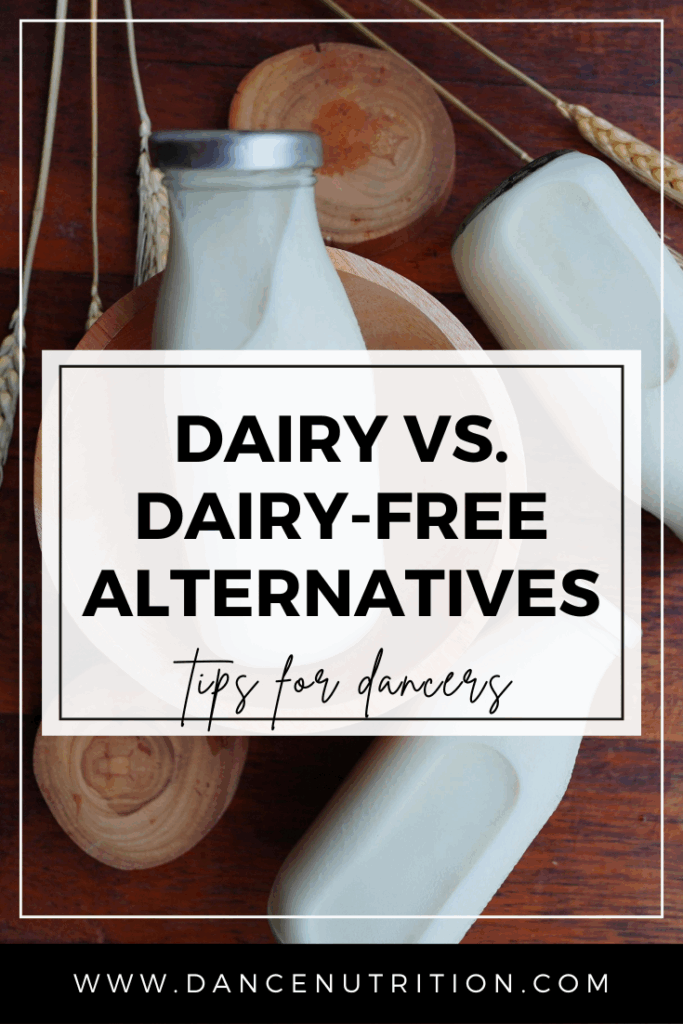Over the past decade, the milk aisle has become more crowded than ever. From soy to oat to cashew, dancers today have endless options. Many choose dairy-free milk even without an allergy or intolerance, often influenced by diet culture messaging.
But what if you do have a medically diagnosed lactose intolerance? Or a milk protein allergy? And for dancers who prefer dairy-free alternatives, is there a “best” option? Let’s break it down.
Why Milk Matters for Dancers
Milk, whether dairy or plant-based, can be a valuable source of:
- Bone-building nutrients such as calcium, vitamin D, vitamin K, and phosphorus
- Protein, which supports muscle repair and recovery
- Immunity support, as vitamin D functions like a hormone to strengthen immune health
Because dancers often train indoors, vitamin D deficiencies are common. That’s one reason why milk and fortified alternatives can play a key role in a dancer’s fueling plan. Vitamin D not only enhances the absorption of both calcium and phosphorus, but it also acts as a hormone and supports immunity. When choosing the best option, factors to consider include:
- Medical needs (intolerance versus allergy)
- Cost
- Environmental impact
- Nutritional profile
Cow’s Milk: Why It Still Deserves Consideration
Despite its questionable reputation in some circles, cow’s milk offers a nutritious and economical option. The protein in dairy is considered “complete,” or high in biological value. This means it contains all essential amino acids needed for anabolic growth and, when compared to plant-based alternatives, is most efficiently absorbed and utilized by the body.
Nutritional highlights:
- Approximately 8 grams of complete protein per cup.
- Naturally rich in calcium and often fortified with vitamin D.
- Offered in a variety of fat levels (skim, 2%, whole), which influence taste and satiety.
It’s worth noting that fat-containing varieties, such as 2% and whole milk, support the absorption of vitamins A and D and provide more satisfaction and flavor. I’ve previously discussed why dancers should not fear fat. Reconsider if you’re choosing fat-free or skim milk for the purpose of wanting a “healthy” alternative. Skim milk may feel “lighter,” but it can be less filling and less efficient from a nutrient absorption standpoint.
For lactose intolerance, lactose-free cow’s milk is nearly identical in nutrition, simply without lactose (the natural sugar in dairy). Given that approximately 75 percent of the population has some level of lactose sensitivity, this option can be very helpful.
Is Cow’s Milk Unhealthy?
No, but dairy production does carry a carbon footprint, and concerns about animal welfare persist. Organic or local dairy may help reduce transit-related emissions between farm and store. Organic dairy also has a longer shelf-life (a result of pasteurization practices).
Plant-Based Milk Options for Dancers
If cow’s milk isn’t an option, plant-based alternatives are widely available and often fortified to match dairy’s nutrient profile. They’re also known to be more environmentally friendly, with CO2 emissions lower than those from dairy farms. Here’s how the most common options compare:
Soy Milk
- Closest in protein to cow’s milk, with 7–8 grams per cup
- A complete protein, supporting muscle recovery and growth
- Frequently fortified with calcium and vitamin D for bone health
- Creamier than almond, cashew, or rice milk, offering a satisfying mouthfeel
- If worried about the hormones in soy, particularly because soy contains a plant estrogen called phytoestrogen, current research does not support claims that soy increases breast cancer risk.
Nut Milks (Almond, Cashew)
- Very low in protein, with about 1 gram per cup
- Lower in calories, fat, and carbohydrates, which partly explains their popularity
- Can taste thin or watery, leaving less satiety
- More suitable for coffee or cereal than as a recovery drink after dancing
Oat Milk
- Creamier than nut milk
- Slightly higher protein content than nut milk, with about 4 grams of protein per cup
- Often fortified with calcium and vitamin D
- A good option for smoothies or post-class recovery
- Typically more expensive than cow’s milk, sometimes costing four times as much (almost 50 cents per cup!)
Coconut and Rice Milk
- Minimal protein content (0–1 gram per cup)
- Naturally sweeter in flavor
- Not ideal for recovery, but may be preferred for taste
Are Dairy-Free Milks Unhealthy?
Some dancers worry about additives such as gums or stabilizers in plant-based milk. However, these ingredients serve functional purposes. In a recent interview with HuffPost, I explained that “many consumers fear additives in food, but the truth is, these additives serve a very functional purpose not only to improve the taste of our food but also make our food safe for consumption.”
The same holds for milk.
Fortified plant-based milk is safe and often nutritionally comparable to dairy, provided you choose options that include added calcium and vitamin D.
The Bottom Line: Milk for Dancers
If protein intake is a priority, especially after class or rehearsal, cow’s milk or soy milk will provide the best support. If your overall diet already includes sufficient protein, then choosing a milk based on taste preference, cost, and sustainability is perfectly reasonable. Here’s your takeaway:
- Best for protein: Cow’s milk or soy milk
- Best balance of creaminess and moderate protein: Oat milk
- Lightest taste with minimal protein: Almond or cashew milk
- Most budget-friendly: Cow’s milk
- Most environmentally sustainable: Most plant-based alternatives
Fueling well as a dancer isn’t about choosing one “right” milk. It’s about finding the option that supports your body, aligns with your values, and feels most satisfying.



